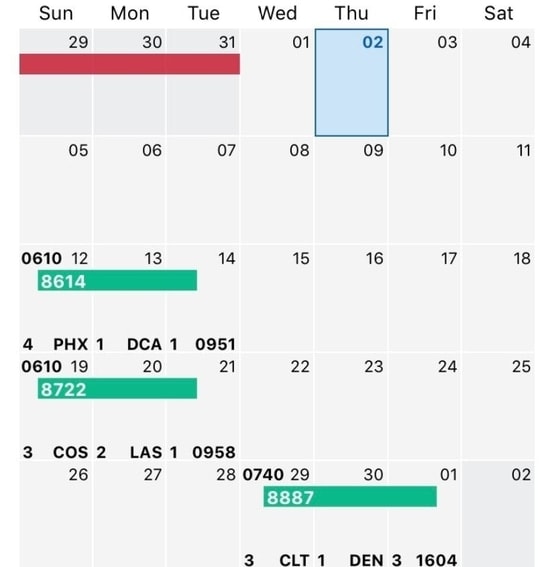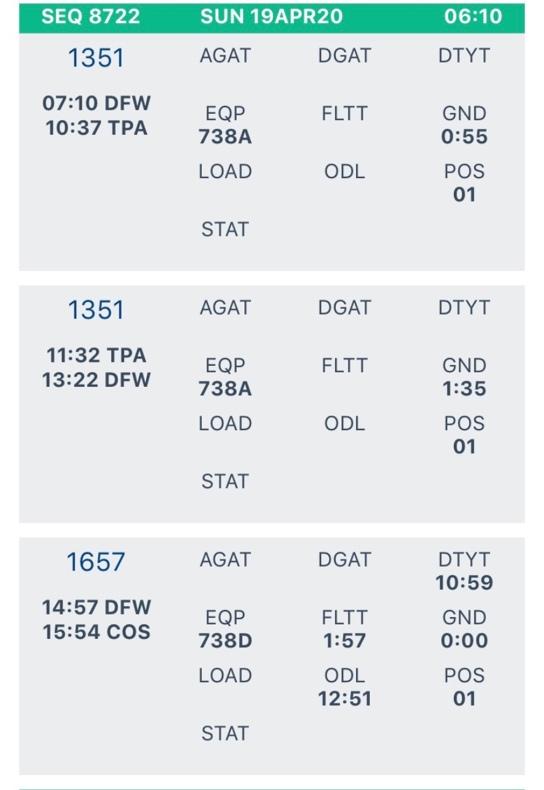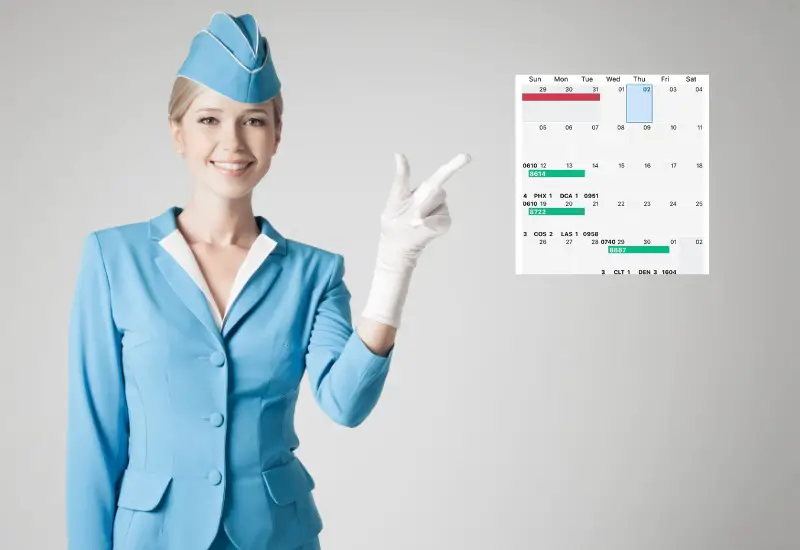In this article, discover the essentials of Flight Attendant schedules: their workdays, layover logistics, and accommodation arrangements. Get a clear picture of what being a flight attendant really involves.
💡 Key Takeaways
- Monthly Schedules: Flight attendants receive a monthly roster detailing days off, flight assignments, on-call days, and layover destinations.
- Seniority Influences Preferences: Senior flight attendants have priority in bidding for preferred schedules and destinations, affecting the quality of their assignments.
- Variety of Trips: Schedules include different types of trips like short turns, multi-day trips, and long-haul international flights, each with specific durations and layover times.
- Layover Dynamics: Layovers, not counted as days off, vary in length, offering different amounts of free time for activities or rest.
- Accommodation and Meals: Airlines provide accommodation during layovers and a per diem for meal expenses.
- Flight Swaps and Schedules: Crew members can swap flights using airline-specific systems, and schedules are usually issued a month in advance.
Table of Contents
What Does Roster Mean?
Roster is really just another term for schedule.
A schedule, which comprises the entirety of the next month.
The month prior, each of us receives a schedule.
Something that we literally wait for, to determine what our lives are going to look like for the next month.
It shows things such as:
- Our days off
- What flights we are going to be working
- Days you are going to be “on call” for the company (available waiting for a phone call to get a flight)
- Show-times (when you need to be at the airport clocked in)
- Your hotel assignments
- How many flights you are going to be working in a day
- Your layover destinations
- etc.
Let’s just say, that what shows up on that schedule, determines everything!
One reason why it is so important to try to bid (send your preferences) for a schedule that you want.
However, the more years you’ve been working for your airline, the better your schedule is going to look.
All of this is subjective, of course.
Each person has their own idea of what the perfect schedule looks like.
We each have our own preferences.
Example of trips
- Turns
- You work one flight to a destination, no layover, and work the flight back
- Two-day trips
- You could work anywhere from one leg (flight) to three legs in a day. Some airlines do fly more than three flights in a day, but the airlines I’ve worked for, the most is usually three
- These trips give you at least one layover in a select city. The layover time can range from usually around 10 hours to 24 hours, but some do have longer layover times, but this could then push it into being considered a three-day, depending on the times.
- Three-day trips
- The same applies to how many legs you would be flying in a day, depending on the company as stated prior
- You will be away from your home base (where you start and end your trips), for three days
- You would usually have two layovers
- rs, but could have only one if your layover is really long
- Four-day trips
- This is usually the longest most people will be gone, for one trip. You can fly consecutively for seven days in a row before you have to have a day off, but you would need to back up multiple trips for this to happen.
- Long-haul trips
- This would usually be considered flights that are over seven hours in duration
- Example: Dallas to Shanghai
- Many are international trips
- Some airlines have crews who only fly international trips and others who fly only domestic trips. This usually depends on preference and seniority
- These long-haul flights usually get paid more, due to international pay, and are primarily composed of senior flight attendants who generally fly the same trips.
- These flight attendants have to be trained specifically for the aircraft they are flying, but most airlines are training new hires to be trained on all of their fleets
How Much Do Flight Attendants Work? How Many Days Off Do They Have?
This really depends on each airline and each specific month changes.
Based on the specific contract each one holds or the company type of operation.
It’s hard to know how many hours we work or how many days off we have on average. I only know my days off (9 days), and what days I am going to be on-call (or on standby: available for work at a moment’s notice) for the company.
Each Flight Attendant has to bid (send their preferences) for a schedule that they want. Some people like to fly high-time (lots of hours, say, 130), and others like to fly low-time (40) and have more days off.
However in this industry usually seniority determines what schedules you get. You are not guaranteed to get what you want.
Example: one month you might be able to hold a long New York layover, but another month you can only hold a short Las Vegas layover. It depends on your seniority, how many people bid for the same trip…
Basically, we never really know what we are going to hold unless we have been flying for a really long time.
We live month-to-month.
Not to mention, that in the US most flight attendants have a rotating schedule: one month we have a line (which means that we know our monthly schedule of trips ahead of time, where we are flying) and other months we are on reserve* (also called standby: available to operate a particular flight just in case someone calls sick, and you don’t know where or when you will be working).
*reserve, standby, on call: they are all synonyms
While on reserve, you are basically there to help the company when they need you. You could potentially get called last minute to operate a flight. If someone calls sick for a flight, or if a crew member has reached the maximum flight duty period… you will get called to work.
Do Flight Attendants Get Free Time on Layovers?
Free time on layovers really depends on the length.
When you have a 24-hour layover, you have time to really go out and see the sights.
Other layovers are so short, you truly only have time to go to the hotel, take a shower, eat and go to bed.
I personally like the long layovers; I got this job to see the world.
Others have been doing this for so long, they would rather just fly as many hours as they can, have short layovers, and get back to their families.
While on your layover, you can really do as you please.
Some people like to stay at the hotel and relax, others really like to go out and see the location they are at.
I am personally the kind who wants to go out and see as much as I can.
This could be going to museums, zoos, parks, restaurants, sites that the city is really known for, etc.
Sometimes you get crews who are all on the same page and really want to stay together and go out.
Other times, you’re on your own. Each crew you fly with is different.
Do the Airlines Pay For Accommodation and Cover Meal Expenses?
The airlines do have to pay for your accommodation when you are working on a trip.
This is something they set up entirely.
Meal expenses are covered by the per diem (meal allowance) we receive, but it isn’t stipulated that it has to be for meals.
It goes into our paycheck with the rest of our pay, and we can do with it as we wish.
Is a Layover Counted as a Day Off?
Our layovers are not counted as days off, no matter how long the layover.
The minute you leave your home base (say you are based in New York), you are considered to be working, until you are back at your home base (New York).
Example of a Roster
Here is an overview of what a schedule could look like.


I understand that it may be hard to read, but I will give you some information to help you see it clearly.
The first image shows an overview of the entire month.
Each green grouping is a pairing: a trip that will be flown.
This schedule has three trips for the month, the rest of the days are off days.
This would also be considered a line since this individual knows what they are going to be flying.
Second image: now let’s take sequence 8722, which operates on April 19th.
You will see that this individual is going to start their day in DFW, airport code for Dallas Fort Worth, and end up in COS, Colorado Springs. They will be flying three flights that day.
- EQP: Equipment type.
- GND: Ground time. How long they are in one location for, before flying off again.
- POS: Flight Attendant position.
- DTYT: Duty day (10:59)
- FLTT: Flight Time
- ODL: Layover time (12:51)
Each day will show different information, depending on what that individual is doing that day.
If you were to click on 1657, the last flight of the day, it would give you more information on where you will be staying that evening, what van is going to be picking you up, etc.
Can Flight Attendants Pick Which Destinations They Want to Fly To?
As stated previously, you can try to pick the destinations you wish to fly to, but it really depends on your seniority and what other people are also looking for.
As a somewhat junior Flight Attendant, bidding for a Frankfurt, Germany trip would be futile.
I just don’t have the time on the job to get this trip.
You quickly start to learn which layovers you can hold, and which ones you’re only going to see, potentially, when you are on a reserve month and available to the company.
That’s when other Flight Attendants, who are senior to you and holding these trips, could call in and you’re next on the reserve list to take that opening.
Then when you get your schedule for the next month, you learn if you were successful in that pursuit, or not.
Can We Swap Flights With Other Crew Members?
We do have the ability to swap flights.
Each company has their own system you can utilize to do swaps.
Most airlines have a website you can go in and drop the trip you want to get rid of, or swap.
Dropping, you can see if anyone is interested in picking up the said trip, if they do, you are off the trip.
Most also have a way that you can message another crew member and see if they would like to trade trips with you.
It is really just dependent on the program that each airline has, and the parameters you have to follow.
You cannot just swap with another crew member, and not let the company know.
This is for: security purposes, legalities each airline needs to follow per Federal Aviation Association, etc.
When Do Flight Attendants Get Their Schedules?
Each airline is different.
Some get them the month-prior: at the beginning of the month, others are given near the end of the month.
Regardless, you usually have two weeks before you need to work said schedule, to get everything you need in order.
They are always given out on the same day, each month, per what the specific airline has in their contract.
Conclusion
The airline industry can be really hard to understand unless you are actually in the job itself.
They are regulated by the federal government, as well as by the specific contracts that each airline has at the time.
Many also have unions, who, among many other things, help negotiate the contracts that the individual companies are held by.
I hope this sheds light on some of the common questions people have, in regard to the life of a Flight Attendant.
If you have more doubts, please do not hesitate to ask me in the comments.




Hey, I was wondering if you would share or recommend some good airlines to work for?
Hey Sarah, you’re in luck! As a matter of fact, we already have an article about the best airlines to work for
the best airline to work for in my opinion is montego airways 😉
Hey! Great info. Thanks for sharing. 😊 I’m currently going through the process and considering a career as a FA. I’m wondering how much notice you will typically get when you are on reserve?
Hey Emilie! They are usually 2 types of ways to be on reserve.
Ready reserve: you have 2-3 hours to arrive at the airport.
Standby reserve: those shifts of 4-6 hours spent at the airport in a designated waiting room.
We have another article explaining more in detail about being on reserve, you should check it out.
Is this a typical schedule for someone who is going to start the job? Or is this a schedule for someone with more years of experience?
Also, as a starting flight attendant, do you USUALLY get more flights (assuming national flights) compared to those with seniority?
Hey Anna, sorry this is just a very simplified example. It’s not realistic. The number of flying days is not sufficient, and there are no reserve days included.
You WILL definitely get more flights in real-life!
We’ve done a similar article tailored for American Airlines Flight Attendant schedules. This one is 100% realistic (pulled from Adrienne’s schedule), you should go check it out.